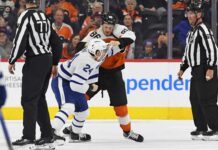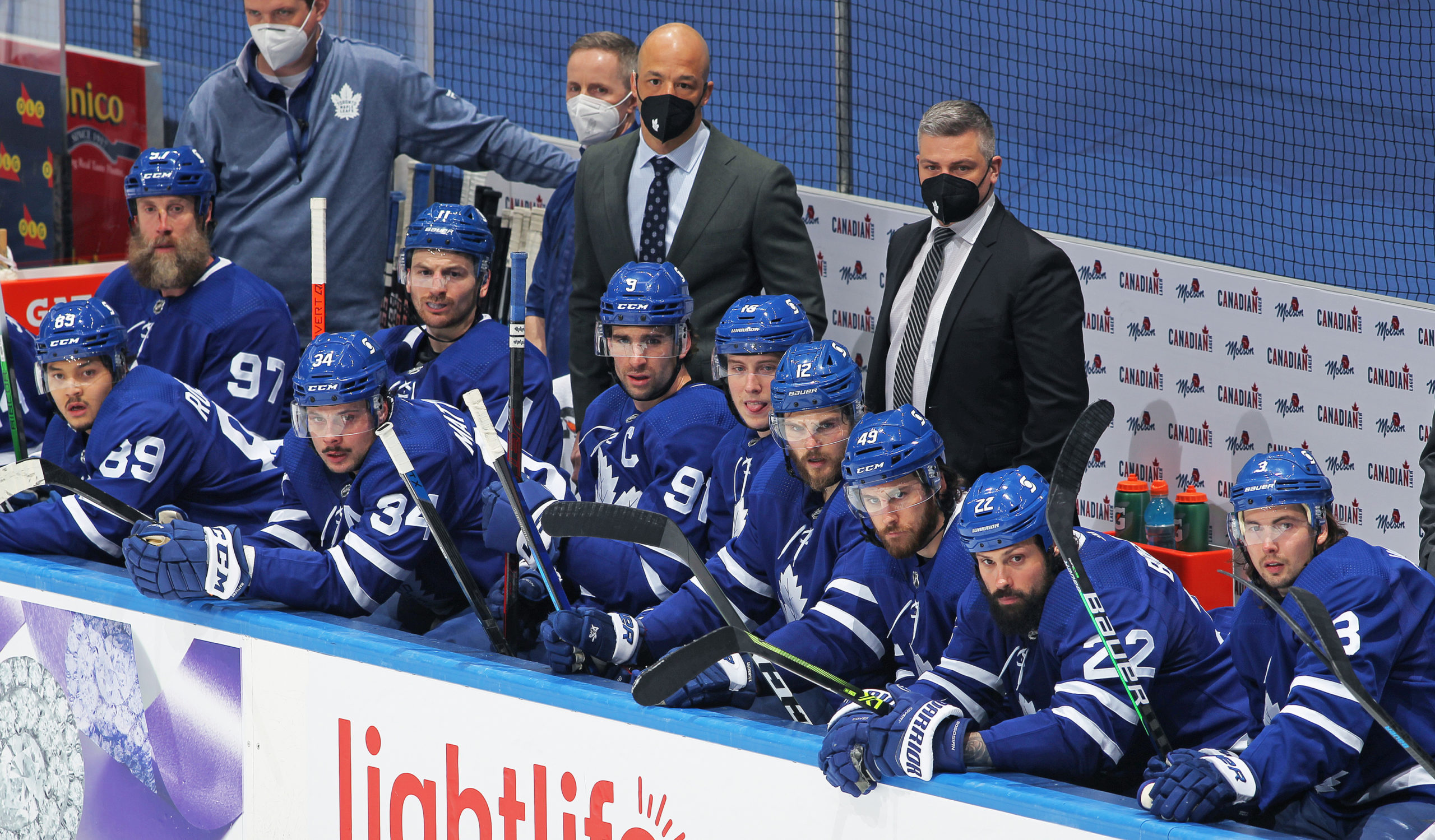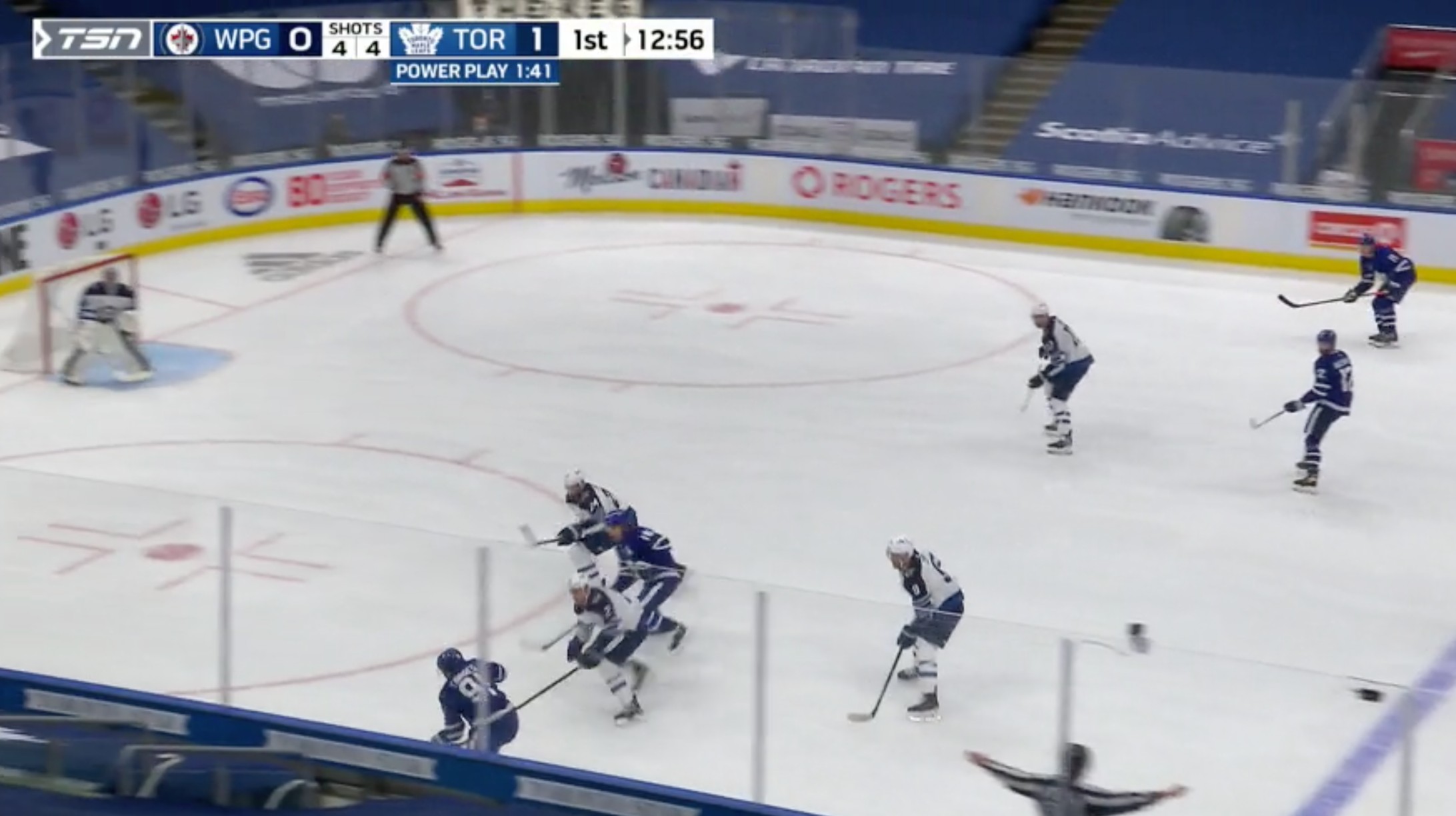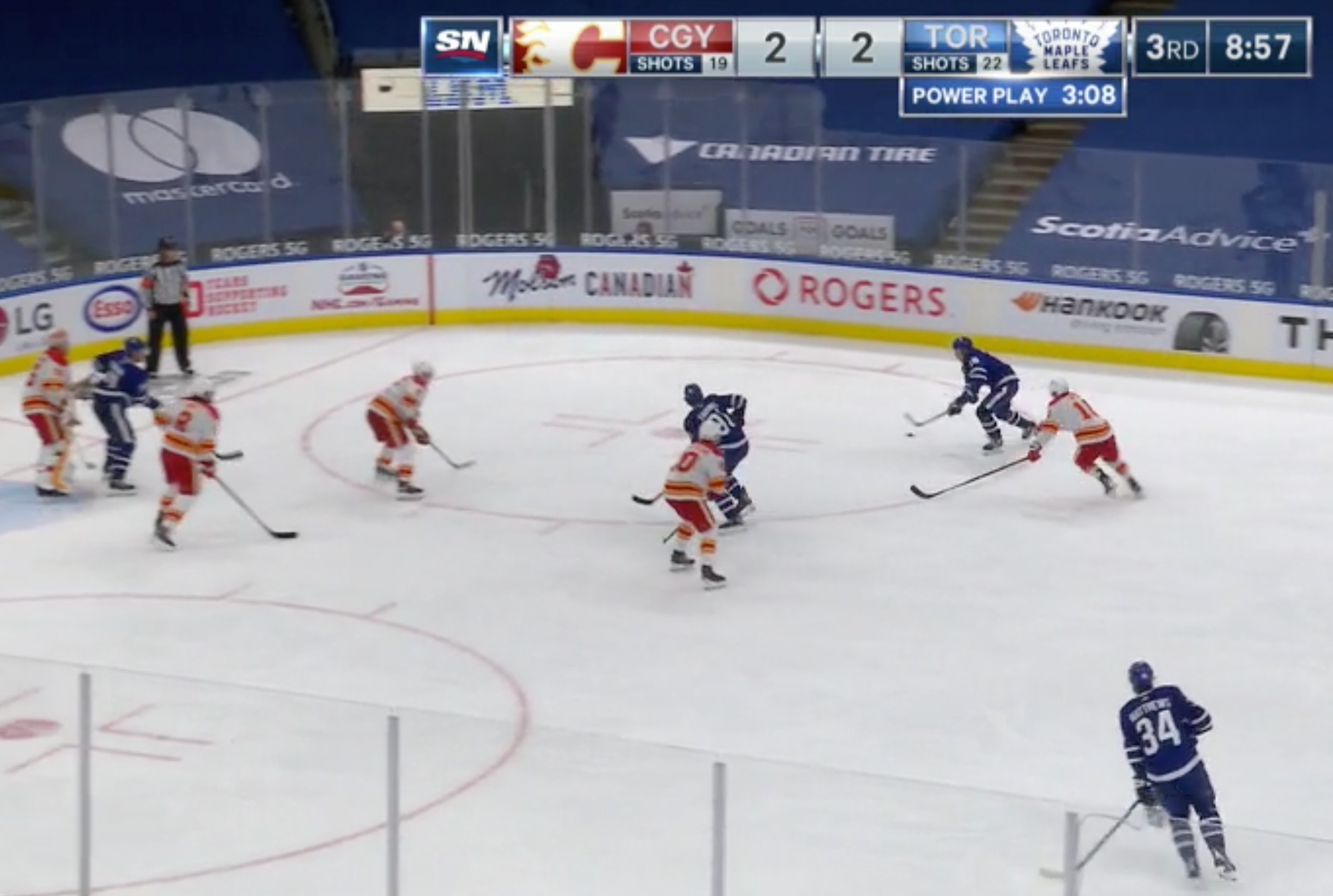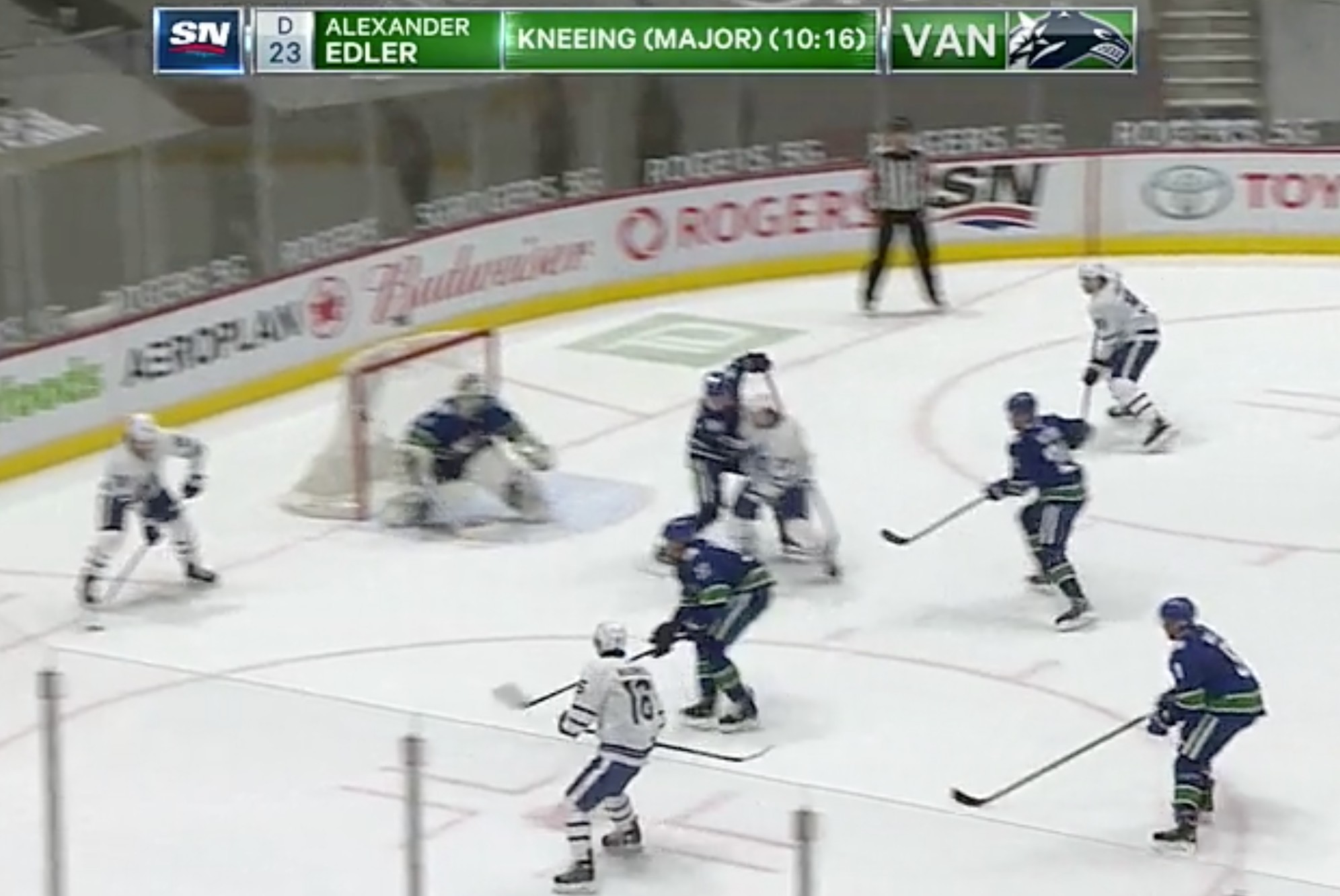The post-trade deadline stretch run to the playoffs is finally here, but it hasn’t started the way the Toronto Maple Leafs would have drawn it up.
On top of a number of key players missing time and a mini-losing slide forming, the Leafs‘ special teams have been — to put it mildly — horrendous.
Since March 1, the Leafs‘ power play ranks second-last in the league at 8.9 percent and the penalty kill ranks last at 70.8. In that time, the Leafs’ special teams have a minus-nine goal differential.
That’s not an impossible differential to live with over the course of 23 games, but it sure is making life harder than it needs to be.
Before we get into some of the things that have been plaguing them, how the Leafs are trying to fix them, and some additional ideas they could consider, I was curious enough to look back on the special team success rates of the best playoff teams in recent history.
Among the last ten Stanley Cup Finalists — a total of 20 clubs — these are the overall results on special teams:
| Team | Year | Power Play Percentage |
|---|---|---|
| Boston Bruins | 2010-2011 | 11.4% |
| Vancouver Canucks | 2010-2011 | 20.4% |
| Los Angeles Kings | 2011-2012 | 12.8% |
| New Jersey Devils | 2011-2012 | 15.3% |
| Chicago Blackhawks | 2012-2013 | 11.4% |
| Boston Bruins | 2012-2013 | 17.5% |
| Los Angeles Kings | 2013-2014 | 23.5% |
| New York Rangers | 2013-2014 | 12.6% |
| Chicago Blackhawks | 2014-2015 | 17.9% |
| Tampa Bay Lightning | 2014-2015 | 20% |
| Pittsburgh Penguins | 2015-2016 | 23.4% |
| San Jose Sharks | 2015-2016 | 24% |
| Pittsburgh Penguins | 2016-2017 | 20.5% |
| Nashville Predators | 2016-2017 | 16.9% |
| Washington Capitals | 2017-2018 | 29.3% |
| Vegas Golden Knights | 2017-2018 | 18.5% |
| St. Louis Blues | 2018-2019 | 16.3% |
| Boston Bruins | 2018-2019 | 32.4% |
| Tampa Bay Lightning | 2019-2020 | 22.7% |
| Dallas Stars | 2019-2020 | 22.4% |
| Average | 19.46% |
| Team | Year | Penalty Kill Percentage |
|---|---|---|
| Boston Bruins | 2010-2011 | 84.4% |
| Vancouver Canucks | 2010-2011 | 80.8% |
| Los Angeles Kings | 2011-2012 | 92.1% |
| New Jersey Devils | 2011-2012 | 73.2% |
| Chicago Blackhawks | 2012-2013 | 90.8% |
| Boston Bruins | 2012-2013 | 88.7% |
| Los Angeles Kings | 2013-2014 | 83.3% |
| New York Rangers | 2013-2014 | 85.4% |
| Chicago Blackhawks | 2014-2015 | 79% |
| Tampa Bay Lightning | 2014-2015 | 82.4% |
| Pittsburgh Penguins | 2015-2016 | 79.7% |
| San Jose Sharks | 2015-2016 | 85.1% |
| Pittsburgh Penguins | 2016-2017 | 83.6% |
| Nashville Predators | 2016-2017 | 89.1% |
| Washington Capitals | 2017-2018 | 76% |
| Vegas Golden Knights | 2017-2018 | 79.5% |
| St. Louis Blues | 2018-2019 | 75.4 |
| Boston Bruins | 2018-2019 | 88.4 |
| Tampa Bay Lightning | 2019-2020 | 86.1% |
| Dallas Stars | 2019-2020 | 79.6% |
| Average | 83.13% |
If you’re looking for hope right off the bat, it’s that championship teams generally do not ride hot special teams to the Cup – in part, as we know, that is because the refs put the whistles away in the playoffs, where 5v5 play is king. Washington won the Cup killing 76 percent of penalties, which is roughly where the Leafs are at right now. The Blues won the next season with an even worse number, and they played a Bruins team that had a scorching-hot power play in the Finals.
But the Leafs’ power play is performing way below the respectable average successful teams put up in the playoffs, and it’s starting to legitimately cost the team games now. There is reason to worry beyond the surface, too, as the Leafs’ shot rates on the power play have plummeted, and we have seen clear evidence that they are in their own heads at this point — bobbling pucks for no reason, forcing passes through traffic, and taking low percentage shots on net at times.
The first item that stands out: They are struggling to simply gain the zone. The drop pass neutral zone play is flat-out robotic at this point, and while it receives a ton of attention and negativity, it’s generally inconsequential in regards to the result. The most important player on the breakout is the player who receives the pass along the boards after the initial skate up the ice, is stonewalled on the entry, and flips it over (which is anticipated and happens pretty well every single time).
In this screenshot below, that player is John Tavares, and this is a common formation we see on the power play:
Penalty kills are really loading up to take away the options here – the Jets have three of their four players there! One is on Tavares to hurry him, one is taking away any sort of play to Marner or chip to the corner, and the other is trailing so that Tavares can’t simply bank a pass back to the defenseman.
On this play, Tavares actually made the right read and rimmed it all the way around to Zach Hyman, who we see at the top of the screen wide open. You don’t have much time or space to make this read, and teams are making it really difficult on the Leafs here.
Back when JVR was a Leaf, he was excellent at this read. It’s critical to their entry success — Marner, Matthews, or Rielly, as the typical puck carriers, are not simply carrying it in. Early in the season, the wall player had a lot more time as the opposition was selling out on the puck carrier.
That is not the only difference from the power play that started the season. Going back and watching their early success, the thing that stood out to me the most: movement. Players were rotating all over the zone and were often interchangeable.
Watch this early season goal against the Senators that results in a clean one-timer look for Matthews inside the faceoff circle:
That movement has been replaced by a lot of static players passing the puck around. Some of this, it should be noted, was just the simple result of the Leafs constantly changing the power-play units and players appearing unsure of their roles and where to go. The lack of timing — or much smaller things like certain stick placements — has been evident at times. And teams have also forced the Leafs into unfavourable positions.
This is a very common setup we have seen from the Leafs over a good chunk of the season. The danger here is minimal at best, though, and opposing penalty kills know it now.
Marner has zero power-play goals this season, and his only real option here is to shoot. Hyman is down low in front of the net, but as a right-handed shot, his stick is facing in, so there is no passing option there to slide it down low. Tavares is in the slot, but the Flames are on it as most teams are at this point – Marner used to love this play with Nazem Kadri years ago, and the opposition has mostly adjusted.
The Flames are also working to cut off the cross-ice pass to Matthews, essentially funneling Marner to the net to shoot. He could curl out of this and/or bank it back to Rielly, but again, this is not leading to or creating any danger; it is simply maintaining possession.
Earlier in the season, the Leafs had the cross-ice pass available. That same Calgary team was burned on it in January by the Leafs. Marner made this pass for an easy Matthews goal (by his standards, anyway).
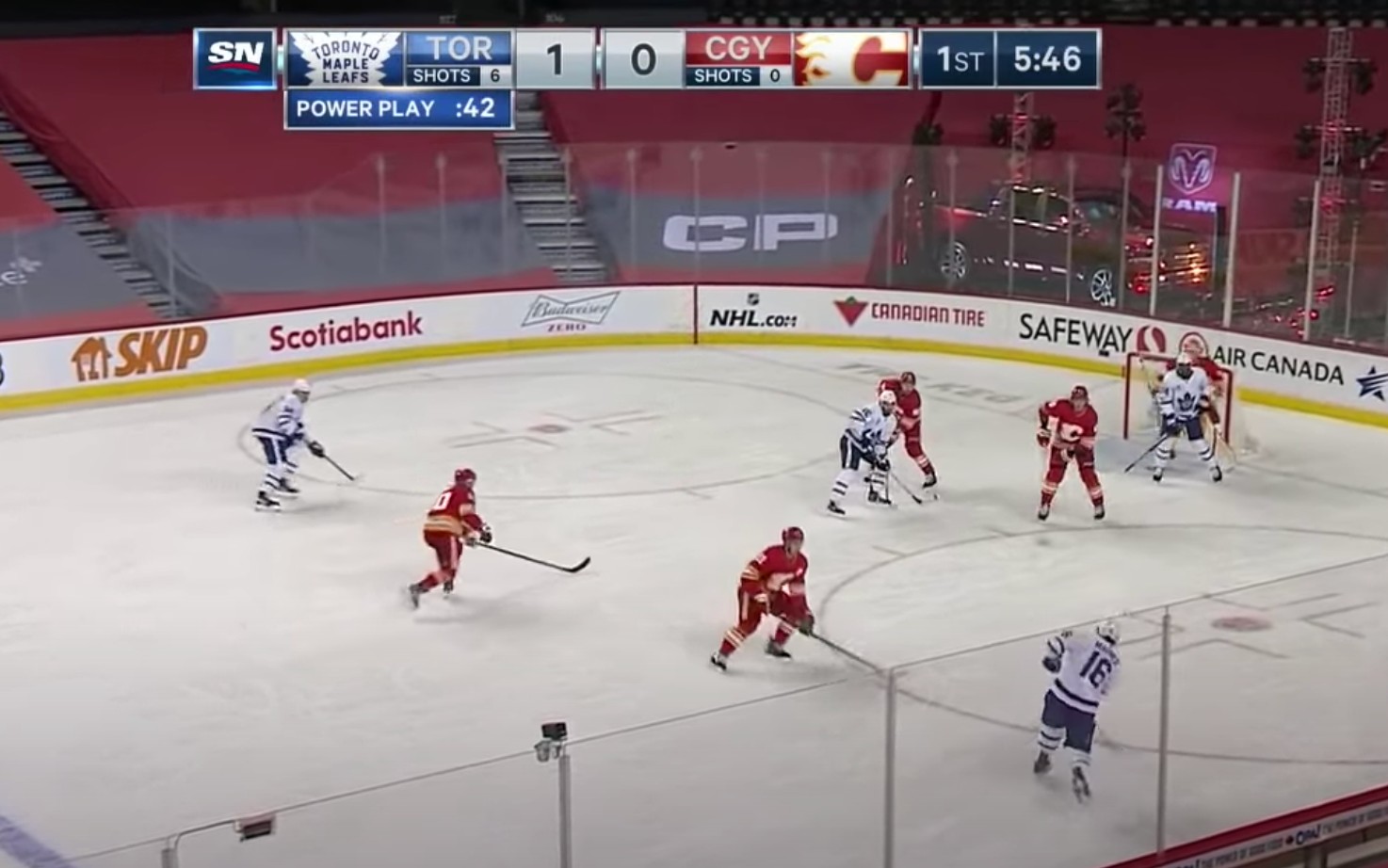 The Leafs, for obvious reasons, try to set up Matthews to shoot in time and space, working it from the wall on the other side to him for either a one-timer (when he’s on the right side) or a wrist shot while in stride. Among players with at least 100 minutes at 5v4, Matthews ranks ninth in shots per 60 and he leads all Leafs regulars in power-play shot rates.
The Leafs, for obvious reasons, try to set up Matthews to shoot in time and space, working it from the wall on the other side to him for either a one-timer (when he’s on the right side) or a wrist shot while in stride. Among players with at least 100 minutes at 5v4, Matthews ranks ninth in shots per 60 and he leads all Leafs regulars in power-play shot rates.
They are trying to get Matthews the puck, but teams have taken the cross-ice pass away. Now, it’s basically a case of the puck working to Matthews on the half-wall, where he has to try to get it through traffic while he’s harassed.
What the Leafs really don’t do at all is twofold.
Firstly, they don’t create anything else of note by using their other players to take attention away from Matthews. The penalty kill can fully sell out on Matthews and cheat towards him – no other Leaf has shown he can make teams pay for doing so.
The second part here is they don’t use the mere threat of Matthews’ shot – and it’s about as big a threat as you can get – to actually create any space for others. Matthews will either try to get the puck through traffic, as noted, or he will bail on the play and toss the puck back up top to Rielly, who has almost nothing — he isn’t able to one-time the puck home, and if he passes it all the way back to Marner, the power play essentially resets to a static position.
In the latest game against Vancouver — they didn’t score on any sort of set play on the power play, but they were at least dangerous — what they tried to do is something they need to do more of moving forward: Create chances from the goal line and behind the net. On this play, Marner froze the defenders and slid it down low to Nylander, who had time and space to operate (the Leafs came really close to scoring):
With Matthews on the half-wall, the availability of this type of play will be even more profound. This type of tic-tac-toe power-play goal should be available to the Leafs with semi-regularity considering the shooters they have. Ultimately, they need the puck on Matthews’ stick more to start, and they need a counterpunch play to punish teams for selling out on it.
And they also need to gain the zone cleaner.
Notes
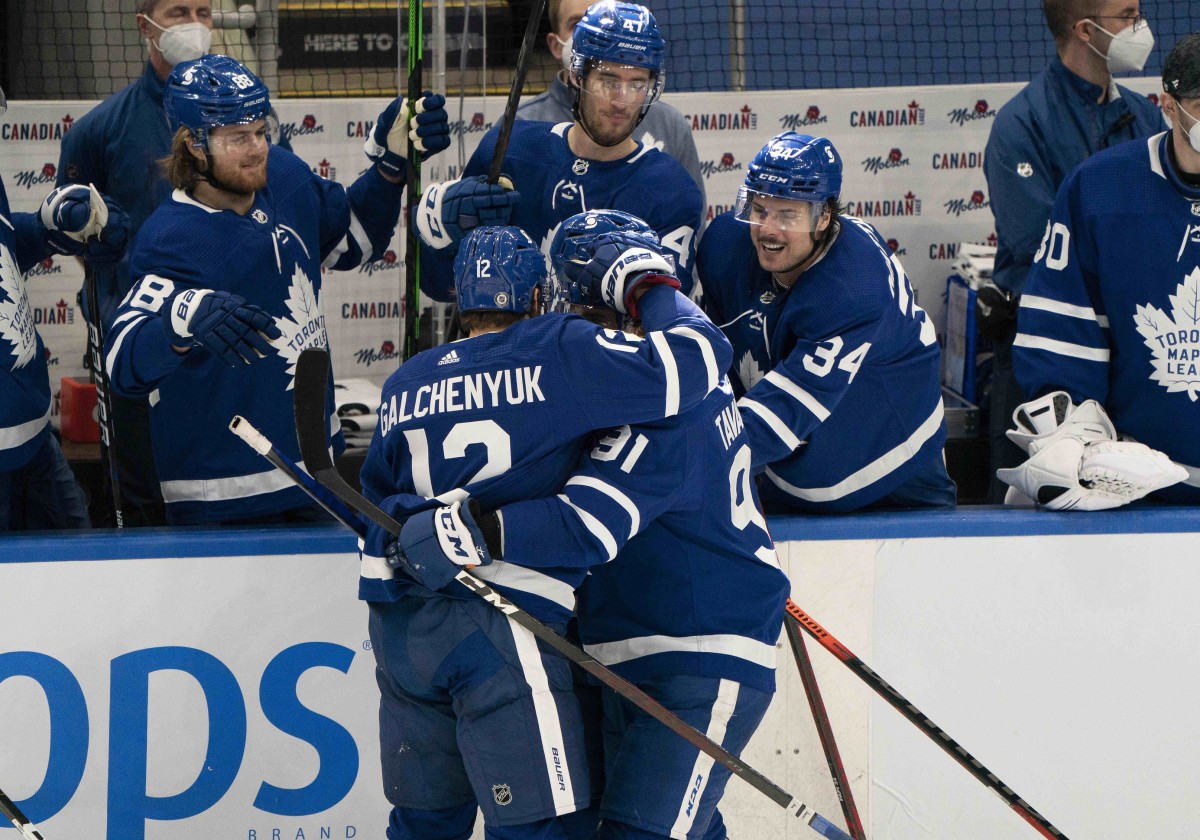
– Against the Jets, Justin Holl logged his second-lowest time on ice of the season at 16:15. In the next game against the Canucks, he was up a little at 18:57, as the Leafs tried shaking up the top four defense pairings for the first time in the season. In the 12 games prior to those two, Holl played 20+ minutes in all of them (and 25+ in two of those), so it’s a notable dip in ice time.
It’s not the main part of his game, but he’s pointless in 10 straight games now. Quietly, he and Muzzin are actually below water in shot share (49.17CF% at even strength), although they have outscored opponents by six and have an expected goals for percentage of 55.68.
– Steadily seeing a rise in his ice time? Alex Galchenyuk. In his first 10 games as a Leaf, he played over 15 minutes once (and it was 15:06). In the five games since, he has played over 15 minutes in all of them (the lowest time on ice was actually 15:24) with a high of 17:37. He’s up to seven points in 15 games, but he has been a bit snakebitten– the career 11.9% shooter is shooting just 7.1% as a Leaf.
– The John Tavares production bounce back continues – after three straight games with two points amid a five-game point streak overall, he’s now at 40 points in 45 games. Nice to see him find his form with playoffs so close by.
– Paul Maurice loaded up a line of Dubois – Scheifele – Connor against the Leafs, and Sheldon Keefe matched it at home with a line of Galchenyuk – Tavares – Marner. They then followed it by matching Mikheyev – Kerfoot – Hyman against the line of Ehlers – Stastny – Copp. I was surprised by that approach, but it could also just be some experimenting prior to playoffs with the team missing a number of players. The Hyman line outshot the Stastny line, while the Tavares line was outshot by the Scheifele line.
– With Zach Hyman knocked out of the game, Wayne Simmonds moved up to the third line with Kerfoot and Mikheyev over Spezza and Thornton. The Leafs generally kept the top two lines intact and rolled with them throughout the game.
Quotes
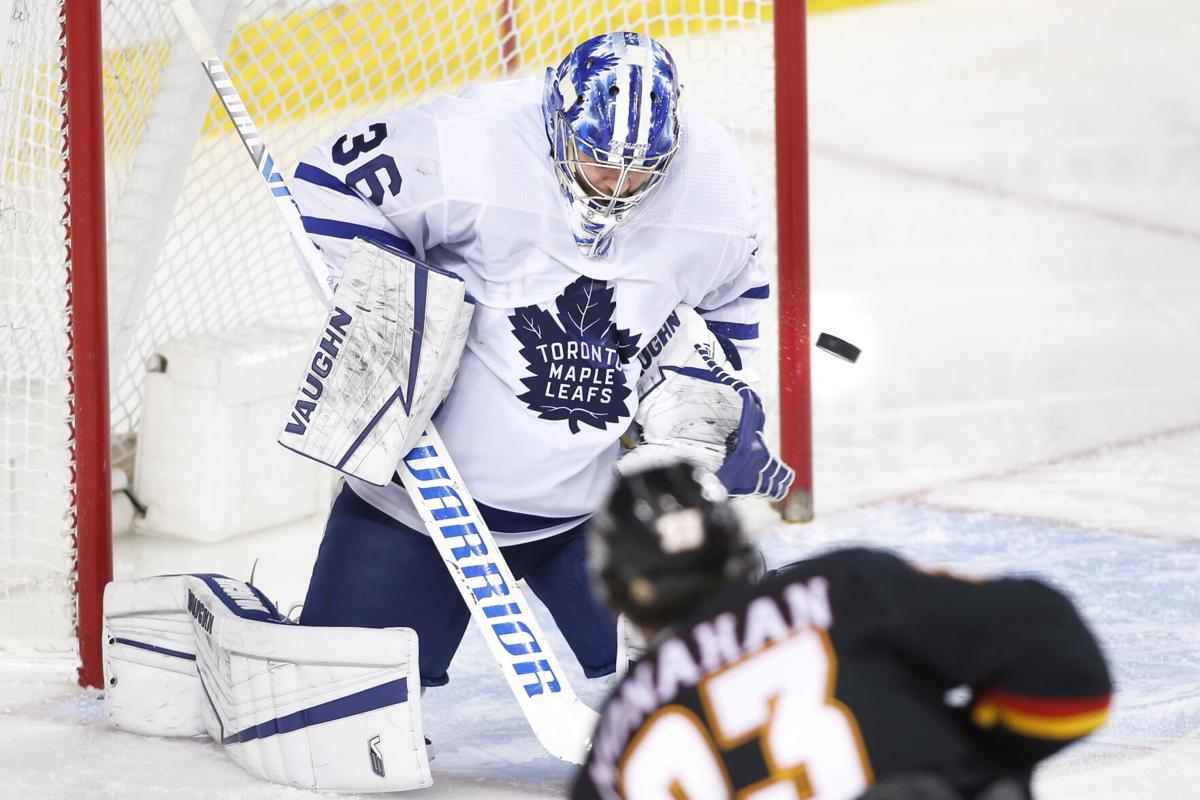
“I’m embarrassed by my effort, to be honest. I cost us the game.”
– Jack Campbell after a loss to the Montreal Canadiens
“Giving up three in the first, it’s unacceptable. All three goals I should have. No exception.”
– Jack Campbell after allowing three goals in the first period and getting pulled against the Winnipeg Jets
I found these quotes to be a bit self-destructive, and for a goalie that has been notoriously hard on himself during his career, Jack Campbell simply won’t last long in this market if this is how he is going to react every single time the Leafs lose or he has a bad game. There’s a time and a place, to be sure, but hardly anyone who watched the game against Montreal thought to themselves, “The goalie should be embarrassed.” After the loss against Vancouver, he was much more subdued, which is a welcome change.
“Wrist flared up on me pretty bad at the end of the Montreal game. It wasn’t feeling much better against Calgary at home, so, just decided to take the game and get some work on it and just kind of let the inflammation and everything settle down and it felt pretty good tonight.”
– Auston Matthews on why he missed the game against the Jets
Amid all the chaos of the deadline, now the COVID loss to the Canucks, plus the Hyman situation, Auston Matthews and his wrist seem like the biggest overall storyline to me. There was no indication that he wouldn’t have played if it was a playoff game or anything like that, but by all accounts, it sounds like something he is just going to have to play with and battle through for the rest of the season, including in the playoffs. He should be trying to rest it now when it flares up, but it’s not a great sign moving forward.
“I think there are also some advantages to being on the road and just rolling your lines and forcing your opposition to adjust to you. All of that said… you’re competing to put yourself in the best position possible. And for us, we’ve been in first for a good portion of the season, and that’s something we’ve wanted because it shows we’re doing good things.”
– Sheldon Keefe on the advantages of finishing first and home-ice advantage in the playoffs
I often think coaches psych themselves out a little bit on the road, especially if you’re a team like the Leafs. They have one line that they really need to shelter (whoever is on the fourth line). Otherwise, they can actively heat seek optimal matches up for the top line.
I have also noted here a few times that they load up the top lines at home and push Hyman down to the third line while on the road. There might be something to that. An argument could be made for ensuring there are three strong lines the Leafs can roll at times – whether at home or on the road.
Tweets of the Week
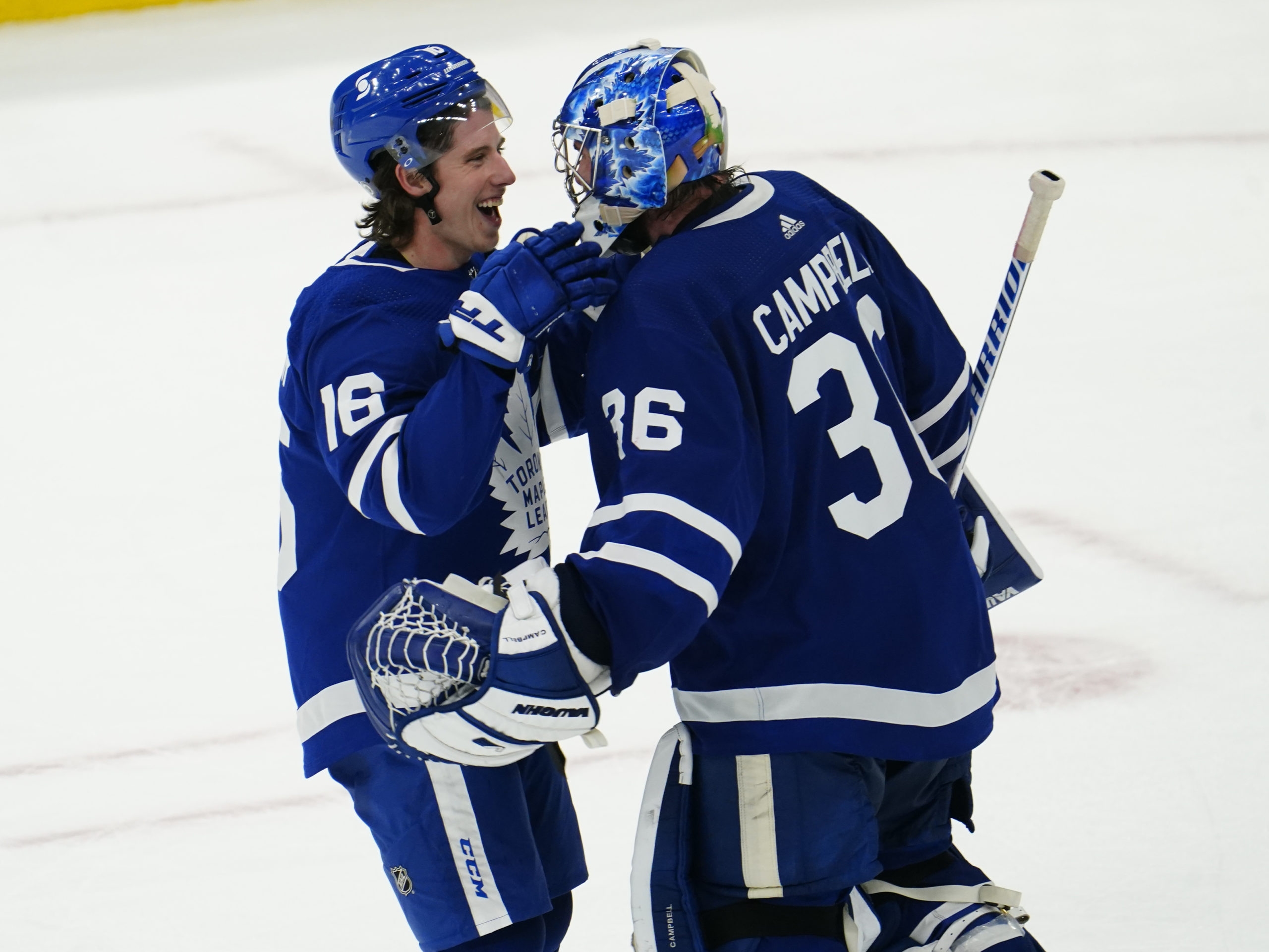
Some perspective:#Leafs have lost two (2) games in regulation since March 19.
So they've earned 21 of a possible 28 points in the last month, while tied for second-best points % in the NHL.
This isn't their best stretch of the season, but the sky isn't exactly falling either.
— Kristen Shilton (@kristen_shilton) April 19, 2021
The reactions to the Vancouver game will be a bit overblown considering the main reason they won is Braden Holtby. The Leafs are still in a fairly comfortable position and should be getting more reinforcements soon (news on Hyman notwithstanding). There are 11 games left in the regular season for them, and at some point, they need to ramp up for the playoffs. I’m not overly concerned just yet, but some worry has definitely crept in.
This hit me hard.
It really has been Hyman, Matthews, Nylander and Marner all growing together since 2016.
To see them excel now is amazing. pic.twitter.com/3B0Q9RDnRW
— Omar (@TicTacTOmar) April 14, 2021
The Leafs have yet to actually accomplish anything or even advance past a round in the playoffs, but they finally have legitimate hopes of doing so and it took them since 2015 to get here. Building with youth is not an easy process — their development brings a lot of ups and downs in a league where the winning teams traditionally feature a good number of productive veterans. Really, though, this is the season that the Leafs have to take a step forward and make some real noise come playoff time.
Most Points in #LeafsForever History Through Player's First 5 Career Seasons:
Mitch Marner – 345
Lanny McDonald – 344
Rick Vaive – 339
Auston Matthews – 338
Vincent Damphousse – 329— Sportsnet Stats (@SNstats) April 16, 2021
Seems there is a new Leafs record broken every week between Matthews and Marner.
5 Things I Think I’d Do
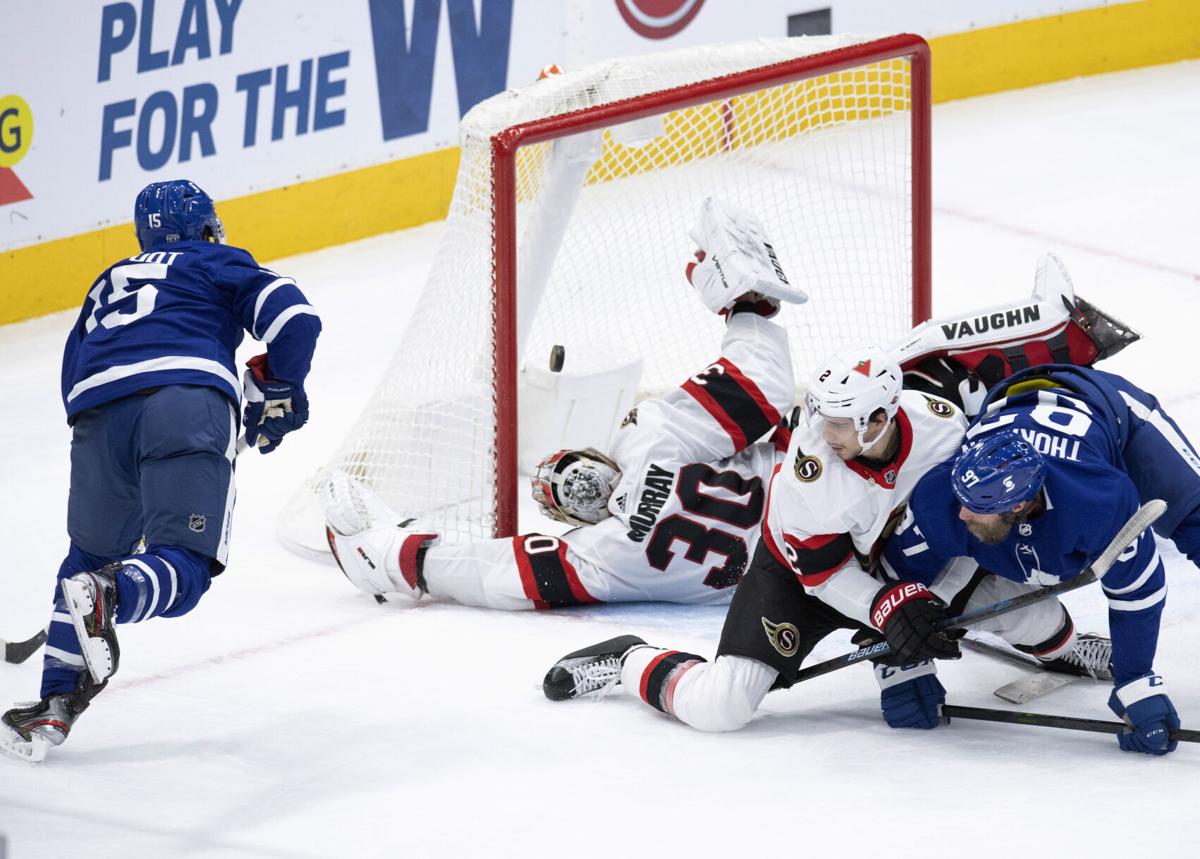
1. I think Jack Campbell is coming back to earth — which was to be expected — and how he works his way out of it will tell us how much he should be trusted in the starting role come playoff time. He had a dream start to the season and was a great story, but reality is hitting a bit right now. It’s easy to be happy-go-lucky when everything is going well, but we’ll see what the response is like now that things are evening out. I’d still give him the bulk of starts down the stretch unless something major changes.
2. I think I get why Sheldon Keefe struggles with Pierre Engvall as a player – he is genuinely frustrating – but I still like the look of the third line significantly better with him centering it over Alex Kerfoot. The veterans on the fourth line seem to need Kerfoot’s speed (and if Hyman’s out, the Tavares/Nylander combo might need it a bit, too).
3. I think Nick Robertson has had some nice moments, and it was nice to see him playing with skilled players compared to last week (we noted it made no sense to play him with grinders). He’s skilled and can create a bit offensively, but I haven’t seen him do anything of note yet that would suggest he should actually be in the starting lineup come playoff time.
4. I think it was nice to see the Leafs shake up the top four a little bit. Their two best defensemen at 5v5 right now are clearly Jake Muzzin and TJ Brodie, as Justin Holl has not been particularly impressive of late. Ben Hutton should clearly receive a look with the group as well. For a group that has been so stable throughout the season, they could be getting a little shakeup here late in the season. It is fair to do so.
5. I think my main takeaway from the game against Vancouver — where a team played after a long absence due to COVID-19 — is this: I’m thankful the players, coaches, staff, and league overall have found a way to have a season. This pandemic has been tough in a number of ways, but having some hockey to turn on has definitely put a smile on my face more than a few times over the last few months.







